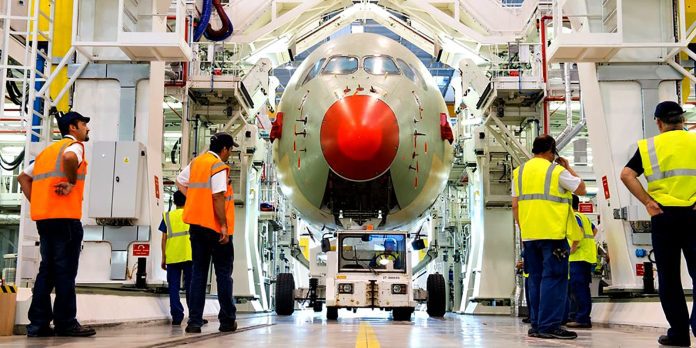Note, this was originally intended to be a two part series covering Airbus’ four essential lessons for Industry 4.0. Here, we are inserting another entry and another lesson, of sorts, into the middle of the planned schedule. Watch out for the final instalment; sign up for the newsletter here.
An important aspect of the digital architecture Airbus has established is to bring computer processing power to the tools in the hands of its factory workers.
Airbus, as we have heard, is big on drilling – 120 million holes go into the fuselage, empennage, wings, and other body parts of its airplanes; 75 per cent of these are drilled by hand.
Amid the advanced automation and analytics on its production line, the European aeropsace company recognises the high impact of its regular workforce on its product and brand, and wants digital technologies to bring insights that raise their contribution.
For Airbus, the process of digitisation is not just about connecting programmable logic controllers (PLCs) on the shop floor, explains Sébastien Boria, R&D technology leader at Airbus, speaking at a recent HPE event in Switzerland. “Humans are unpredictable,” he explains.
Motion sensors are required to record their movements; embedded systems are needed to control the data logic. “Just solving the problem with OPC-UA won’t help. Because most of these tools – most of the clients integrated within them – are not PLCs. They are micro-controllers and digital signal processors,” he explains.
The hand tools, themselves, are running bespoke embedded systems, with ‘real-time’ constraints, and some compute power, memory, and a radio. “My OT world is more about embedded systems than just connecting things,” he says.
Boria’s role at Airbus is to tread the middle line, between IT and OT, and bring the two sides closer.
The difference, for Airbus, is many of its industrial devices are set to send data at low-frequency, low-latency intervals. In terms of their noise and discretion, they are silent and smart compared with default industrial setups, where data feeds indiscriminately into a centralised cloud function.
“Those are thin clients; what I call stupid clients,” says Boria. “They are really like TCP connectors. They might have a fancy function, like a display, but they aren’t intelligent – they are verbose; [data goes from] one system to another, without filtering, and without adding value.”
Airbus wants a closer hand in the dialogue, to manage the flow of data. “It’s just a computer version of Industry 3.0. It’s not Industry 4.0 – 4.0 means you are an actor in your digitalisation process. It’s not just data logging, which is fine, but it’s not enough.”
Airbus has developed and drafted-in its own factory tools for its production line, with their own custom compute systems and middleware.
“We don’t buy tools anymore that are only designed for the purpose they are meant for; yes, the driller has to drill, but it is also an actor with computation power, which will influence other parts of the process,” explains Boria.
The company is marrying these with robust connectivity (“not persistent, but there when we need it”), and strict rules about data transmission. “We don’t want verbose communication if it doesn’t fit with the action.”
This goes back to its low frequency and low latency requirements for data transmissions. “Instead of a fancy network link that gathers data every three seconds, we are keeping the information in the tool,” he explains.
Unless there’s an anomaly to report, Airbus’s bespoke drills transmit every 20 minutes. “It sounds a long time,” he says. But it is right for aerospace manufacturing. “If you have a takt time of 20 or 30 seconds, like in automotive, it is far too long. But our takt time is 12-16 hours.”
The key, it seems, is not the frequency; with repetitive tasks, the intelligence comes from filtering out the repetitive data – at source. On a 12-hour shift, manual tasks might be performed thousands of times across the production line.
The cleverness comes from knowing – in as near to real-time as possible – when the process or the product (or the process before the product) goes awry, and adjusting the production line to make light work of the discrepancy.
“It doesn’t have to be live; its just has to be there on time. Sometimes you have errors – you have a drilling that doesn’t go right. What we want is not just to train / trade that. But what is better is to be able to correct and repair the hole before we go to the next stage.”
A new report and webinar on edge computing in industrial IoT setups, called AI and IoT at the cutting edge – when to move intelligence closer to the action, is available; go here for the report, go here for the webinar.

